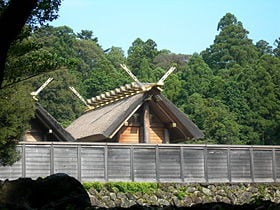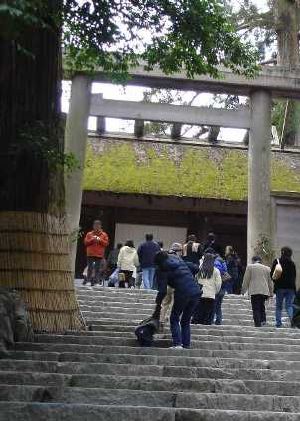Ise Shinto
Ise Shrine (Ise-jingū 伊勢神宮) is a Shinto shrine to the goddess Amaterasu ōmikami, located in the city of Ise in Mie prefecture, Japan.
Ise Jingū
Officially known simply as Jingū or "The Shrine," Ise Jingū is in fact a shrine complex composed of over one hundred individual shrines, divided into two main parts. Gekū (外宮), or the Outer Shrine, is located in the town of Yamada and dedicated to the deity Toyouke no ōmikami, while Naikū (内宮), or the Inner Shrine, is located in the town of Uji and dedicated to Amaterasu ōmikami. The two are located some six kilometers apart, joined by a pilgrimage road that passes through the old entertainment district of Furuichi. The High Priest or Priestess of the Ise Shrine must come from the Japanese Imperial Family, and watches over the Shrine.
According to the official chronology, the shrines were originally constructed in the year 4 B.C.E., but most historians date them from several hundred years later, with 690 C.E. widely considered the date when the shrines were first built in their current form. Legends say that Naikū was established by Yamatohime-no-mikoto. The shrines are mentioned in the annals of the Kojiki and Nihonshoki (dating from 712 and 720, respectively). The old shrines are dismantled and new ones built to exacting specifications every 20 years at exorbitant expense, so that the buildings will be forever new and forever ancient and original. The present buildings, dating from 1993, are the 61st iteration to date and are scheduled for rebuilding in 2013.
The design of Ise Shrine dates back to before the introduction of Buddhism and Chinese influence on architecture, meaning that it represents an intriguing example of what Japanese architecture was before these more recent influences superseded the indigenous architecture of the Japanese archipelago. The buildings are made of natural wood, with the distictive roof beams consisting of the Chigi, which protrude like horns over the ridge of the roof and on free-standing columns at either gabled end, and the Katsuogi, which are short logs laid horizontally across the ridge of the roof. Overall, the style looks somewhat reminiscent of Polynesian architecture.
The Ise Shrine has a national treasure in its possession. Purportedly the home of the Sacred Mirror, the shrine is arguably Shinto's holiest and most important site. Access to both sites is strictly limited, with the common public allowed to see little more than the thatched roofs of the central structures, hidden behind three tall wooden fences.
The region around the shrines is the Ise-Shima National Park and has numerous other holy and historic sites including the 'wedded rocks' Meoto Iwa, and the Saiku (the site of the Heian period imperial residence)
The establishment of the Shrine
According to Japanese legend, around 2,000 years ago the divine Yamatohime-no-mikoto, daughter of the Emperor Suinin, set out from Mt. Miwa in modern Nara Prefecture in search of a permanent location to worship the goddess Amaterasu-omikami, wandering for 20 years through the regions of Ohmi and Mino. Her search eventually brought her to Ise, in modern Mie Prefecture, where she is said to have established Naikũ after hearing the voice of Amaterasu Omikami saying that she wanted to live forever in the richly abundant area of Ise, near the mountains and the sea. Prior to Yamatohime-no-mikoto's journey, Amaterasu-omikami had been worshiped at the Imperial residence in Yamato, then briefly at a temporary location in the eastern Nara basin.
The Shrine High Priestess / High Priest
From the late 7th century until the 14th century, the role of High Priestess of Ise Shrine was carried out by a female member of the Japanese Imperial Family, known as a Saiō. According to the Man'yōshū (The Anthology of Ten Thousand Leaves), the first Saiō to serve at the shrine was princess Okunohime-miko, daughter of Emperor Temmu, during the Asuka period of Japanese history. Mention of Ise Shrine's Saiō is also made in the Aoi, Sakaki and Yugao chapters of The Tale of Genji, as well as in the 69th chapter of The Tales of Ise (Ise Monogatari). The Saiō system ended during the turmoil of the Nambokucho Period.
Since the disestablishment of State Shinto during the Allied Occupation of Japan, the offices of high priest and most sacred priestess have been held by former members of the imperial family or their descendants. The current High Priest of the shrine is Kitashirakawa Michihisa, a great grandson of the Emperor Meiji. He suceeded his cousin Kuni Kuniaki, the eldest son of former Prince Kuni Asaakira (brother of Empress Kōjun), in 2001. Kitashirakawa's grandmother, Kitashirakawa Fusako, the seventh daughter of Emperor Meiji, served as most sacred priestess of the Ise Shrine from 1947 until her death in 1974. She was succeeded in that post by Takatsukasa Kazuko, the third daughter of Emperor Shōwa, who held the post until ill health forced her retirement in 1988. Takatsukasa was succeeded by her younger sister, Ikeda Atsuko
Naikū - The Inner Shrine
The official name of the main shrine of Naikū is Kotaijingu and is the place of worship of the goddess Amaterasu-omikami. The grounds of Naikū contain a number of structures, including the following:
The Uji Bridge
This wooden bridge in traditional Japanese style stands at the entrance of Naikū and spans 100 meters across the river Isuzu. Like the actual shrine building, the bridge is reconstructed every 20 years as a part of the Shikinen Sengu cermony.
Temizusha
After entering Naikū via the Uji Bridge and passing through a landscaped garden, the next building encountered by pilgrims to the shrine is Temizusha. This small, roofed structure contains a pool of water for use in ritual purification. Visitors are encouraged to wash their hands and rinse their mouths at Temizusha as a symbolic act to clean the mind and body of impurity.
Kotaijingu - the main shrine
After passing through the first and second sacred Torii gates, pilgrims then approach the main shrine of Naikū by a set of large stone steps. Though the actual shrine is hidden behind a large fence, pilgrims can approach the gate to offer their prayers. Photographs in this area are prohibited and this restriction is strictly policed.
Kotaijingu is said to hold the Sacred Mirror, one of three sacred items given to the first emperor by the gods. From a path that follows the line of the outer wall, the distinctive roof of the shrine building can be seen through the trees. In front of the walled shrine compound can be seen an open area which will be the location of the next rebuilding of the shrine in 2013.
External links
- Ise Jingu
- Travel guide to Ise from Wikitravel
ar:مزار إيسه cs:Svatyně Ise de:Ise-jingū eo:Ise-Sanktejo fr:Temple d'Ise ko:이세 신궁 it:Tempio di Ise ja:伊勢神宮 ru:Исэ-дзингу zh:伊势神宫
Credits
New World Encyclopedia writers and editors rewrote and completed the Wikipedia article in accordance with New World Encyclopedia standards. This article abides by terms of the Creative Commons CC-by-sa 3.0 License (CC-by-sa), which may be used and disseminated with proper attribution. Credit is due under the terms of this license that can reference both the New World Encyclopedia contributors and the selfless volunteer contributors of the Wikimedia Foundation. To cite this article click here for a list of acceptable citing formats.The history of earlier contributions by wikipedians is accessible to researchers here:
The history of this article since it was imported to New World Encyclopedia:
Note: Some restrictions may apply to use of individual images which are separately licensed.




